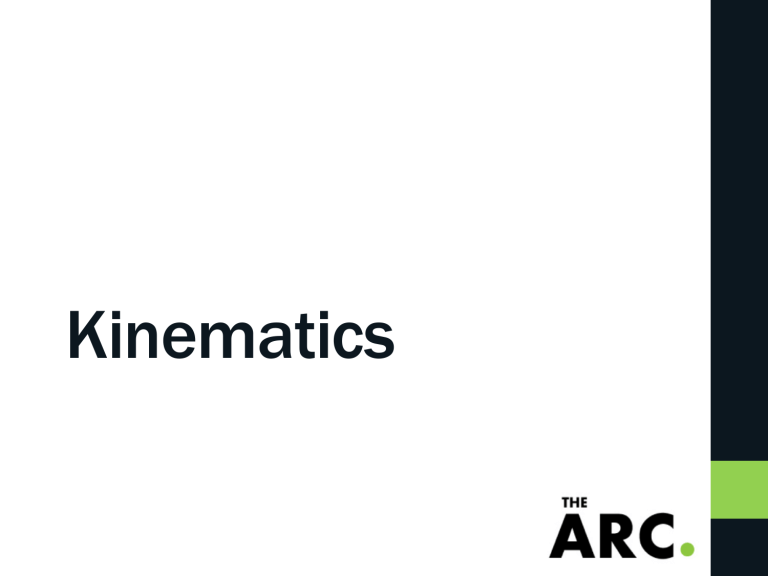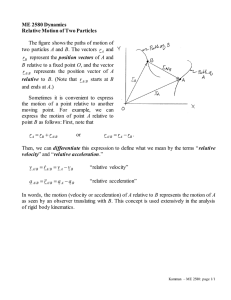
Kinematics Position To specify a position vector you need to specify: • Origin • Distance • Direction If using a 3D right-handed coordinate system with the origin being the reference point for the position vector, it is enough to specify the coordinates x, y and z. For a moving object the position vector is a function of time. Velocity & Acceleration • Velocity is defined as the change in position over a change in time; thus the average velocity is and the instantaneous velocity is • For motion in one dimension the velocity is the slope of the position line plotted versus time. • The same logic is used in deriving the average and instantaneous acceleration resulting in: • Jerk is defined as the rate of change of acceleration: Example 1 • A body starts from rest at x=0. ax(t)=2t-4 [m/s2]. Find the jerk and the position as a function of time. Solution: At rest =>vx0=0; At x=0 =>x0=0 Integrating: vx(t)=vx0+t2-4t=t2-4t [m/s] x(t)=x0+(t3/3)-2t2=(t3/3)-2t2 [m]; jx=dax/dt=2 [m/s3] Example 2 A body is moving along x with a constant jerk. At t=2s, its velocity is 4 m/s. At t=4.5s and t=5s, its acceleration is respectively 2.1 m/s2 and 4m/s2. At t=1s it is at x=3.4m. Determine the position of the body at t=7s. Example 2 Example 3 A body is launched with an initial speed of 50m/s at an angle of 60 degrees with the horizontal from a height of 2m. How far from its initial position will it land? What will be the angle it makes with the horizontal when hitting the ground? Relative Velocity • The position of one body with respect to another is described by its relative position vector, equal to the difference between the position vectors, relative to the origin, of the two bodies: This equation can be rewritten as: Differentiating with respect to t, we obtain: Example • An airplane is moving at a constant speed, equal to 300i+200j+75k with respect to a control tower. A jetfighter is moving at a constant speed, equal to 750i-320j+0k with respect to the same control tower. Determine the speed of the airplane with respect to the jetfighter. VA/J=VA/C-VJ/C=(300-750)i+[200-(-320)]j+(75-0)k = =-450i+520j+75k Rotational Motion The relationships stated for linear motion are also valid for rotational motion, where • The angular position, theta, corresponds to the position vector r • The angular speed, omega, corresponds to the velocity: • The angular acceleration, alpha, is analogous to the linear acceleration: Cable Constraints Assumptions: • Idealized cord • Remains in tension • Undeformable Methodology: • Select a reference point/line to use in expressing position vectors • Using the position vectors of different points on the cable express its length • The length of the cable must remain constant • Differentiate the equation to obtain expressions for the velocity and acceleration. Note that the derivative of the constant length of the cable yields zero Example Example Solution

